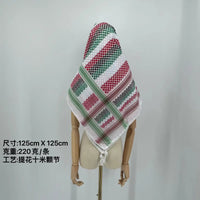When Italian workers walked off the job on Friday(2025.10.3), it wasn’t for higher wages or better working conditions—it was for something bigger: solidarity with the people of Gaza. What unfolded next was a wave of protests that swept Europe, shining a global light on the crisis in Gaza—and highlighting a powerful symbol of unity: the keffiyeh.
For B2B buyers—whether you supply to activist groups, cultural retailers, or event organizers—this moment isn’t just news: it’s a signal that demand for keffiyehs (the iconic Palestinian scarf) is surging as a visual voice for solidarity. Below, we break down the full story of Italy’s historic strike, why keffiyehs are at the heart of this movement, and how our wholesale advantages let you meet this demand fast.
The Story of Italy’s Gaza Solidarity Strike: From Call to Streets
To understand why this strike matters—and why keffiyehs are flying off shelves—let’s walk through the key moments that led to hundreds of thousands taking to Italy’s streets:
1.The Unusual Strike Call:Solidarity Over Pay
Friday’s general strike broke from tradition: Italy’s workers weren’t negotiating contracts—they were demanding action on Gaza. Trade unions and activist groups organized the walkout to protest Israel’s ongoing bombardment and blockade of the Gaza Strip, which UN experts have confirmed has caused famine in Gaza City and surrounding areas. This wasn’t a small demonstration: Italy’s Interior Ministry estimated 400,000 protesters across 29 cities, while unions claimed the number was four times higher (1.6 million)—a sign of how deeply the Gaza crisis has resonated
2.The Spark: Israel’s Interception of the Aid Flotilla
Anger boiled over this week after Israeli forces boarded a flotilla of boats carrying European politicians, activists, and critical food/medical aid to Gaza. More than 40 Italians were on that flotilla—including MEPs and local leaders. Israel dismissed the mission as a “publicity stunt,” confiscated the aid, and detained those on board. For Italians, this wasn’t just an international incident: it was a personal one, with their fellow citizens detained while trying to deliver life-saving supplies.
3.Government Pushback vs. Mass Turnout
Italy’s hard-right leaders pushed back hard against the strike. Prime Minister Giorgia Meloni criticized it as “unhelpful to the Palestinian cause” and suggested unions just wanted a “long weekend.” Her deputy, Matteo Salvini, went further: he called the strike “illegal” (claiming it lacked proper notice) and threatened sanctions against organizers.
But the public didn’t back down. Protesters marched behind banners reading “Stop the Massacre” and “Hands off the Flotilla!” While most demonstrations were peaceful (like Rome’s large, calm march), some cities saw clashes: in Milan and Bologna, protesters threw stones at police, who responded with tear gas. In Pisa, activists with flares stormed the airport runway (halting flights), while Naples dockworkers blockaded ports and Turin protesters blocked railways. The energy spread beyond Italy, too—protests popped up in The Hague, Madrid, and other European cities.

4.Meloni’s Shifting Stance (And Growing Pressure)
The strike has put Meloni’s government under intense pressure. For months, she’s tied Palestinian state recognition to the release of Israeli hostages and the exclusion of Hamas—but recently, she’s softened her tone, saying Israel’s response to the 2023 Hamas attacks has “gone beyond proportionality” and that there are “too many innocent victims” in Gaza.
Political experts (like Luiss University’s Prof. Giovanni Orsina) say this shift is driven by two forces: Catholic public opinion (outraged by Gaza’s suffering) and a “reawakening” of Italy’s left-wing militancy. As Orsina put it: “The government is under pressure and nervous”—and the protests are only growing
5.The Flotilla’s Aftermath: Homecoming and Hope
By the end of the week, four of the detained Italian politicians were deported and returned to Rome, greeted with hugs from family and colleagues. More than 40 other Italians remain in custody, and the aid never reached Gaza—but activists see progress. “Lots of us went because we felt impotent,” said Green Left Alliance MEP Benedetta Scuderi, who was on the flotilla. “I like to think it’s given some hope to Gaza’s population.” She added: “The protests, the strikes—they’re huge. No responsible government can pretend nothing’s happening.”

Why Keffiyehs Are the Symbol of This Solidarity Movement
If you watched footage of Italy’s strikes (or global Gaza protests), you likely saw one recurring item: the keffiyeh. The black-and-white checkered scarf—rooted in Palestinian heritage—has become the universal visual symbol of solidarity with Gaza. It’s worn around necks, tied to bags, and held aloft at marches because it tells a story: of resilience, culture, and unity.
For B2B buyers, this means one thing: surging demand. Here’s who’s looking for keffiyehs right now:
Activist groups organizing solidarity events (they need bulk scarves for protesters)
Cultural retailers (shoppers want to wear their support publicly)
University groups (students are staging sit-ins—like those at Rome’s Sapienza University—and using keffiyehs as a unifying symbol)
Event planners (for Gaza benefit events or cultural gatherings)
The problem? Many suppliers can’t keep up. With protests spreading, retailers and organizers are facing backorders and 3+ week wait times. That’s where we step in.
Our Keffiyeh Wholesale Advantage: Meet the Solidarity Demand Today
We don’t just sell keffiyehs—we help you deliver the symbol of this movement when it matters most. Here’s how we solve the shortages holding your business back:
1.50,000+ In-Stock Keffiyehs (No Backorders)
We keep a massive inventory of authentic 100% cotton/polyester keffiyehs—the classic black-and-white check (the most requested style for solidarity events) plus neutral tones for everyday wear. No more telling clients “it’s out of stock”: we have the scarves they need, ready to ship immediately.
2.Industry-Low MOQ: Start at 10 Units
You don’t need to order 1,000+ units to meet small-group demand. Our minimum order quantity is just 10 units—perfect for student groups, local activists, or boutique retailers testing the trend. Scale up to 10,000+ units for large events: we never cap orders.
3.48-Hour Shipping (Because Protests Wait for No One)
Activists and organizers need keffiyehs fast—for next week’s march, not next month. We ship every wholesale order within 48 hours of payment, with options for expedited air freight (5-7 day delivery to EU/US) or cost-effective sea shipping. For Italy-based buyers, we even offer priority routing to get scarves to your door in time for upcoming events.
Ready to Supply the Solidarity Movement? Contact Us Today
The protests in Italy and across Europe aren’t slowing down—and neither is demand for keffiyehs. Don’t let backorders or slow shipping make you miss this moment.
👉 Get Started Now:
Email us at contact@womanscarf.com for best price
WhatsApp our B2B team at +86-18314991443 to check real-time inventory
Request a free sample (just need shipping!) to feel the quality before you order.
We’re here 24/7 to help—whether you’re an activist group needing 50 scarves for a march or a retailer ordering 500 to stock shelves. Let’s help your clients wear their solidarity proudly—with keffiyehs that arrive on time, every time.






